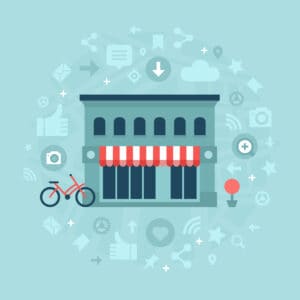
In 2021, online sales were expected to rise by 45.8% from 13.6 percent in 2019, according to eMarketer. While this increase offers a wonderful opportunity for businesses with a big internet presence, it also creates an interesting problem. It keeps track of your company’s success, especially in a B2B eCommerce environment that frequently deals with intangibles like software and services.

While you may find a way to see the bigger picture of where your company stands and where it’s going when deliverables and service transactions are happening at scale, it’s challenging to discover how to do so when dealing with big data.
Ecommerce metrics measure how well your company is doing based on specific criteria. There are several different types of metrics to measure various aspects of performance. The operational and financial aspects should be studied together rather than individually to get a complete picture of a company’s performance. Here’s why they matter:
- Quantification: Metrics quantify what would otherwise be an intangible property. They convert typical company performance into tangible statistics that may be tracked and graphed for future planning and business intelligence reference.
- Planning: eCommerce KPIs aren’t only useful since they indicate what you’re doing well right now; they may also help grow your business marketing strategy. Suppose a firm finds that monthly visits are declining after analyzing a certain Key Performance Indicator (KPI). In that case, they’ll know they need to make adjustments to their marketing strategy plan swiftly to prevent the slide from continuing. You may use Google Analytics to figure out what your repeat customers are searching for. Metrics is a great instrument to discover what your consumers want.
- Motivation: A good practice is to keep key performance indicators (KPIs) and metrics constant, which will help your staff remain motivated and aware of your company’s mission. Measuring employee success by means of KPIs, for example, and giving them bonuses for exceeding normal performance, may assist improve productivity while also maintaining a positive work environment.
Table of Contents
KPIs and Metrics
Before we go any further, it’s worth noting that while the words KPI and indicator are sometimes used interchangeably, they do have a difference. A subset of metrics known as KPIs monitors particular performance indicators, whereas B2B Ecommerce metrics assess an organization’s or company’s growth overall.
Metrics That Matter
There’s no limit to the number of metrics you can measure when you have so much data every day. This has two sides: It might be really simple for organizations to get lost in the mire of information and lose sight of which ecommerce metrics are essential.
B2B buyers are typically most interested in a certain subset of ecommerce metrics, such as cost savings, satisfaction, and productivity. So here are some of the biggest B2B ecommerce metrics to concentrate on.
Customer Retention Rate
The rate consumers return to your online store is the customer retention rate. Customer retention rate assesses whether or not your eCommerce capabilities are sufficient to retain a healthy number of repeat purchasers.
For example, suppose your CRR metrics decrease or your online platform is shifting from sales to sales through your offline locations. In that case, it might indicate that your current B2B eCommerce platform isn’t doing enough to satisfy and encourage customers typically spend to return.
It’s more expensive for organizations to acquire new customers by spending more on roi positive marketing campaigns than it is to keep their current client base and encourage them to return and spend more.
CRR is such a crucial yardstick for B2B firms that don’t have a large pool of devoted consumers to measure their success by.
Customer Acquisition Cost
Customer acquisition cost (CAC) is the amount a firm spends in order to acquire new consumers. It’s calculated by dividing the money spent developing new clients by the total number of new customers acquired over a given period.
The CAC score is a marketing performance indicator that B2B Ecommerce firms can use to assess the success of their marketing efforts and how effectively their budget has been spent.
To put it another way, if you calculate the average return the firm gets for the amount they invest in marketing, you can think of it as a measure of how effective their marketing is.
So, for example, a full content marketing plan customized to target customer segments with accuracy might help decrease CAC and expand your customer base.
Order Frequency
The frequency of purchases is the total number of orders divided by the number of unique consumers a firm has. It represents how many times a consumer makes purchases over the course of a year.
Purchase frequency is another important measure for B2B e-commerce firms that want to keep customers and sell complementary items through established channels such as email lists and social media.
Average Order Value
The average order value (AOV) is a popular indicator that every company should track. AOV is the total amount spent by a client on each order divided by the number of distinct orders, as the name implies.
The AOV metric is important because it is linked to a B2B e-commerce firm’s income. The AOV of your company may indicate that you have a solid remarketing strategy and a broad product range that appeals to your client base rather than only one standout product.
Conversely, a fall in AOV indicates that customers may be dissatisfied or bored with your product line, pushing you to reconsider what your company offers and how it promotes its goods.
Product bundles are one of the most common methods for businesses to increase their AOV and revenue metrics. Customers might be encouraged to buy more goods if they get a product bundle with each purchase. A bundle is a collection of items that have been bundled together to promote sales. Bundles offer customers multiple goods at a discount, yet they are still more expensive than if they purchased only one item. Offers like free delivery above a certain amount of discounts if customers spend a specific amount are two more checkout procedures that can help you raise AOV.
Percentage of Return Visits
The percentage of return visits is a good indicator of how well your eCommerce shopping experience is for new and returning customers. This statistic measures how ‘sticky’ your website is for purchasers, whether you’re a seasoned business with a big online presence or a brick-and-mortar company moving to an internet B2B eCommerce approach.
An increasing proportion indicates that your consumers are pleased with your user experience and eager to make repeat purchases. This could be due to a variety of factors, including:
- Navigation: Some of the most effective strategies to build a shopping encounter that encourages returnees are: Snappy menus and simple navigation on a well-designed website are two of the greatest methods to develop an experience that customers will want to return to. 16% of US internet customers buy stuff every week, and 25% purchase things on a monthly basis. They will naturally pick apps and websites that load quickly, are simple, and have intelligent SEO usage. Your website will be seen in search engines if you employ clever SEO techniques, making it easy to locate new and returning consumers.
- Security: A secure website will help you achieve other B2B Ecommerce goals, but it’ll also give you the confidence to invest in SEO efforts that would otherwise be wasted. A PCI-certified and HTML5-compliant site gives new clients peace of mind about their data and encourages existing customers to return to a place they know is secure.
- Ordering process: It is critical to have a simple ordering procedure in order to maximize the number of repeat visits. Customers will be more inclined to return if they know that their order will go through quickly and won’t require them to submit personal information repeatedly or irritating pop-ups asking them to opt into other programs.
Conversion Rate
No conversation about B2B Ecommerce metrics is complete without mentioning the most well-known one: conversion rate.
Conversion rates single-handedly drive many marketing campaigns, and for a good reason.
Conversion rates are calculated by subtracting the total number of visits that resulted in a purchase from the overall total of site visits.
Whether the interaction is a few minutes or many hours, it’s important to measure how well your company is doing. This statistic finds out whether you’re impacting customers’ purchasing decisions.
It might not always cause concern if you’re getting bad conversions. Conversion rates in the United States were around 2.57 percent in 2020, according to Statista.
While this right metric might sound dishearteningly low, B2B businesses need not doubt their Ecommerce model, as there are plenty of ways to improve it, including:
- Website Optimization: Changing your website’s layout to make sure it loads quickly is a quick and easy approach to ensure customer lifetime value. Even a fraction of a second’s increase in loading times can significantly increase bounce rates, the number of people who abandon your website after seeing its load time. According to Google, the chance of a user bouncing rises from 1% to 123% when page load speeds rise from 1 to 10 seconds.
- Know Your Customer: Enterprises may utilize a few USPs to encourage consumers to place an order. One of them is free shipping information. It’s good to inform customers of free delivery as soon as they purchase.
- CTAs: When it comes to boosting conversion rates, B2B Ecommerce firms typically start by enhancing their Calls To Action, CTAs. More purchases are completed with more appealing language and better website design.
- Internal Benchmarks: Internal metrics and those that evaluate customer behavior and interactions with sellers are crucial tools for B2B companies to measure how effectively their operations are operating beneath the hood.
- Direct Labor: This is the total amount of money spent on directly employing labor for logistics, warehousing, and building work.
- Fulfillment costs: Fulfillment costs are an important B2B Ecommerce benchmarking measure for businesses that supply items to other companies and individuals, whether online or offline. Long-distance logistics charges such as freight and various incidents are included in these expenses.
- Cost per order: The cost per order refers to a firm’s money to bring its goods from storage into consumers’ hands. A high price per order indicates that the business is spending too much on transportation or labor and may anticipate lower margins.
Businesses should regularly perform benchmarking to ensure that their operations are functioning smoothly.
Logistics and labor expenses may gradually rise, putting a strain on businesses. They can cause bottom-line revenue to decline and influence marketing expenditures, altering how companies interact with consumers.



CONNECT WITH US!!